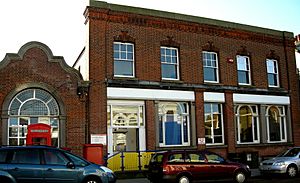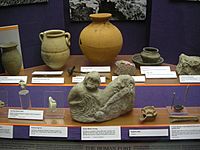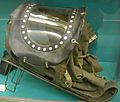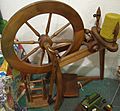Herne Bay Museum and Gallery facts for kids
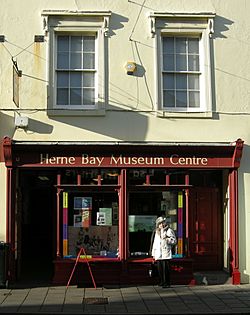
Georgian
|
|
| Established | 1932 as Herne Bay Records Society 1936: 53 Mortimer St, Herne Bay 1939: Library, Herne Bay High St 1996: 12 William St, Herne Bay |
|---|---|
| Location | 12 William Street, Herne Bay, Kent CT6 6BS |
| Type | Local history museum, history of the seaside, art gallery, heritage centre |
| Public transit access | Herne Bay railway station; Stagecoach for buses |
The Seaside Museum Herne Bay is a local museum in Herne Bay, Kent, England. It opened in 1932 as the Herne Bay Museum. It's famous for showing the history of the town as a fun seaside spot. You can also see local art and a special World War II bouncing bomb! The Herne Bay Museum Trust took over running the museum from Canterbury City Council. They reopened it in July 2015 as The Seaside Museum Herne Bay.
Contents
Discover the Museum's Past
The museum started in 1932 as the Herne Bay Records Society. From 1936 to 1939, its exhibits were at 53 Mortimer Street. Then, from 1939, the museum moved above the Public Library on High Street. In 1996, it found its current home at 12 William Street. This building is a beautiful Georgian style building. William Street was once the main shopping street in the town.
The museum was run for many years by local historian Harold Gough. The exhibits belong to the Herne Bay Historical Records Society. They are loaned to the Canterbury City Council museums service. The museum also hosts local art shows. It has a free program of events for visitors.
Meet Dr. Tom Bowes
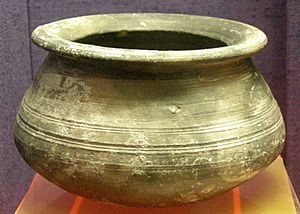
Dr. Thomas Armstrong Bowes (1869–1954) was a local doctor. He was also a historian and collector of old items. He saved many stone tools, pottery, and other objects. These were often found by workers digging in the area. He took photos of historical items for his talks.
Dr. Bowes retired in 1930. In 1932, he started the Herne Bay Records Society and Museum. He gave many of his collected items to the museum in 1936. These were first kept at 53 Mortimer Street. He was the president of the HBRS from 1949 to 1951.
Meet Harold Gough
Harold Gough followed in Dr. Tom Bowes' footsteps. He was a local writer and historian. He also served as the honorary curator of the Herne Bay Records Society. He helped run the museum for many years. For example, he created the museum's displays about the Herne Bay clock tower. He also researched other local landmarks, like Herne Bay Pier. He was president of the Herne Bay Historical Records Society from 1992 to 2008.
Explore the Museum's Collections
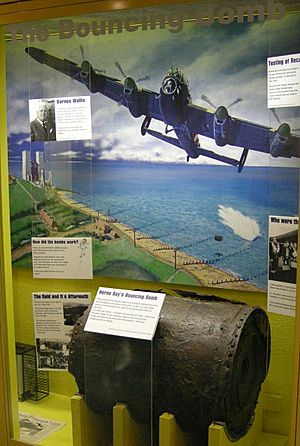
The museum's collections tell a story of 60 million years of history! You can see fossils and Stone Age tools. There are items from the Roman fort and Anglo-Saxon church at Reculver. You can learn about smuggling in Herne. The museum also shows how Herne Bay grew into a popular Victorian seaside resort. It covers the two world wars and local social history.
The exhibits teach about the surrounding area and holidays. They feature the piers, the clock tower, and archaeology. You can also learn about palaeontology (the study of fossils) and local history. Most of the museum's collections are owned by the Herne Bay Historical Trust. They received them from Dr. Tom Bowes.
The Famous Bouncing Bomb
A big draw for visitors is a special World War II item. It's a test version of the Barnes Wallis Highball bouncing bomb. This bomb was tested in the sea near Reculver in 1943. The area was chosen because the water was shallow. This made it easy to get the bomb back at low tide. It was also a safe place and close to RAF Manston.
To make the test bomb weigh as much as a real one, designers filled it with concrete and chalk. The Army found this bomb on the seabed in 1997. It has been carefully preserved for display. A later version of this bomb, called the Upkeep, was used in the 1943 Dambuster raids.
This item was actually a mine, not a bomb. It worked by skipping over the water like a flat stone. This allowed it to jump over torpedo nets. It was designed to hit a dam and roll down to 30 feet deep. At that depth, the water pressure would cause it to explode.
Ancient Finds: Archaeology and Palaeontology

The museum has amazing archaeological finds. These include Anglo-Saxon items from the Saxon church at Reculver. There are also Roman artifacts from the Roman fort of Regulbium nearby.
For palaeontology, you can see mammoth tusks. There's also a fun activity for children to find sharks' teeth. First, you can search in trays at the museum. Then, you can look for them in the sand and small stones at low tide.
There is a display of fossils found in 1939 at Bishopstone. A beachcomber named J. E. Cooper found them. These items are 50–60 million years old! They include sharks' teeth, green sandstone with tiny shell fossils, and fossil wood. You can also see fossil oyster shells and parts of sea lilies. There are even Ice age mammoth teeth!
The Roman Fort at Reculver
This fort was built soon after 43 CE. At that time, it was a mile from the sea. It was at the north end of the Wantsum channel. The Wantsum used to separate Thanet from mainland Kent. The fort likely protected the Roman fleet anchored in the channel.
It was rebuilt in the third century CE. This was to protect the coast from Saxon longship raids. The fort was about 170 by 180 meters. It had walls three meters thick with gates. It was partly surrounded by an earth rampart and two ditches. Inside, the fort had roads, a headquarters, stores, barracks, and a bath-house. It also had its own service village and a road leading to Canterbury.
Roman items found at the fort or nearby in the sea include building blocks. There are also pottery pieces, an iron pin, and an arrowhead. You can see a funerary urn, clay figures, and a marble carving. Other finds include a stone lamp, styluses, and bone pins.
Anglo-Saxon Reculver

In 669 CE, long after the fort was left empty, King Egbert gave land to a priest named Bassa. This was so Bassa could build Reculver church. Most of the church was taken down in 1809. Only two towers were left to help guide ships. Sea erosion has also washed away half of the fort.
Anglo-Saxon finds include a large glass beaker. It was found at Broomfield in 1830. There's also a 5th or 6th century pottery bowl called the Marshside Bowl. A large blue glass bead was found near Reculver.
Victorian Seaside Fun
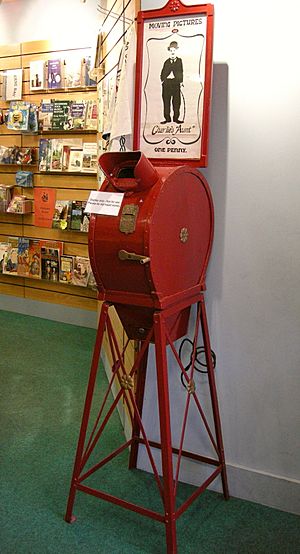
The museum shows how Herne Bay became a popular seaside resort.
Penny Licks
In the 1800s, ice started to be shipped from the Arctic. Ice-cream sellers saw a chance to make money. The first ice-cream cones were actually glass cups. They held a "penny-worth" of ice cream. Sellers on carts didn't have good ways to wash the glasses. They just wiped them clean. Because of this, "penny lick" glasses were banned in 1926 for health reasons.
What-the-Butler-Saw Machine
This "What the Butler Saw" machine is an old mutoscope. It might be from the Edwardian era (early 1900s). These fun machines used many flicking cards. Each card had a photo. When flipped quickly, they made the pictures seem to move. They were cheap attractions found in amusement arcades on piers or by the sea. They often showed funny or curious scenes.
Wall Displays
Displays show early photos of Herne Bay as a seaside town. You can see pictures of local events. There's a story about a girl who won a medal for saving her sister from drowning. Photos also show the history of the fire brigade. You can see the old bathing station and the clock tower.
Local History Exhibits
Exhibits include a model of a pumping engine. An engineer made it in 1884 for the Ford waterworks. There's also a fancy seal press. The Herne Bay Urban District Council used it until 1974. It pressed an official seal onto documents.
Some exhibits cover Herne Bay's wartime history. These include a baby's gas mask from 1939. Among social history items, there's a spinning wheel for wool. It shows how people used to make their own yarn.
Art Gallery
The museum's art gallery has paintings by local artists. These include Thomas Sidney Cooper and William Sidney Cooper. They painted sheep and cattle in the countryside around Herne Bay. The gallery focuses on local scenes. It also shows work by artists connected to the area.
Special Exhibitions
The museum often has special exhibitions. For example, there was an exhibition about the color blue in early 2008. An exhibition about the cartoonist Giles took place in summer 2009. The Herne Bay Living History group helps with some of these shows. The "Make do and Mend" exhibition in late 2009 showed how people reused everyday items during wartime. The museum also holds craft activities and quizzes for families. A permanent exhibition shows Dr. Tom Bowes as a wax model with his collection.
Story Time and Quizzes
From October 2009 to January 2010, there was a "Herne Bay at War" quiz for families. For children under five, there was a story-time hour once a month in 2009.
Images for kids
-
Penny lick glasses
-
Anglo-Saxon glass beaker
-
World War II baby's gas mask
-
1880s model of waterworks pumping engine
-
Official seal press
-
Saxony spinning wheel, part of 2009 "Make Do and Mend" exhibition
-
Search boxes containing coarse sand and fossil sharks' teeth
Saving the Museum
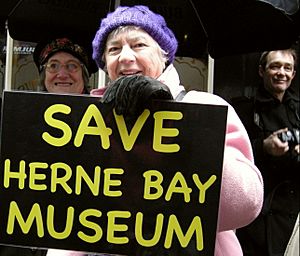
Around 2009, the museum faced the risk of closing. This caused a lot of discussion. In February 2010, the Canterbury City Council voted to close the museums in 2011. However, they agreed to fund them for the 2010–2011 financial year. They also planned to work with other groups to keep the museums open.
On December 9, 2010, the Herne Bay Times announced that the museum was saved! About 2,000 fans had fought to keep it open. The Department of Culture and Enterprise agreed to a rescue plan. This plan included a small entry fee for visitors who didn't live in the area. Local residents and children could still visit for free.
See also


